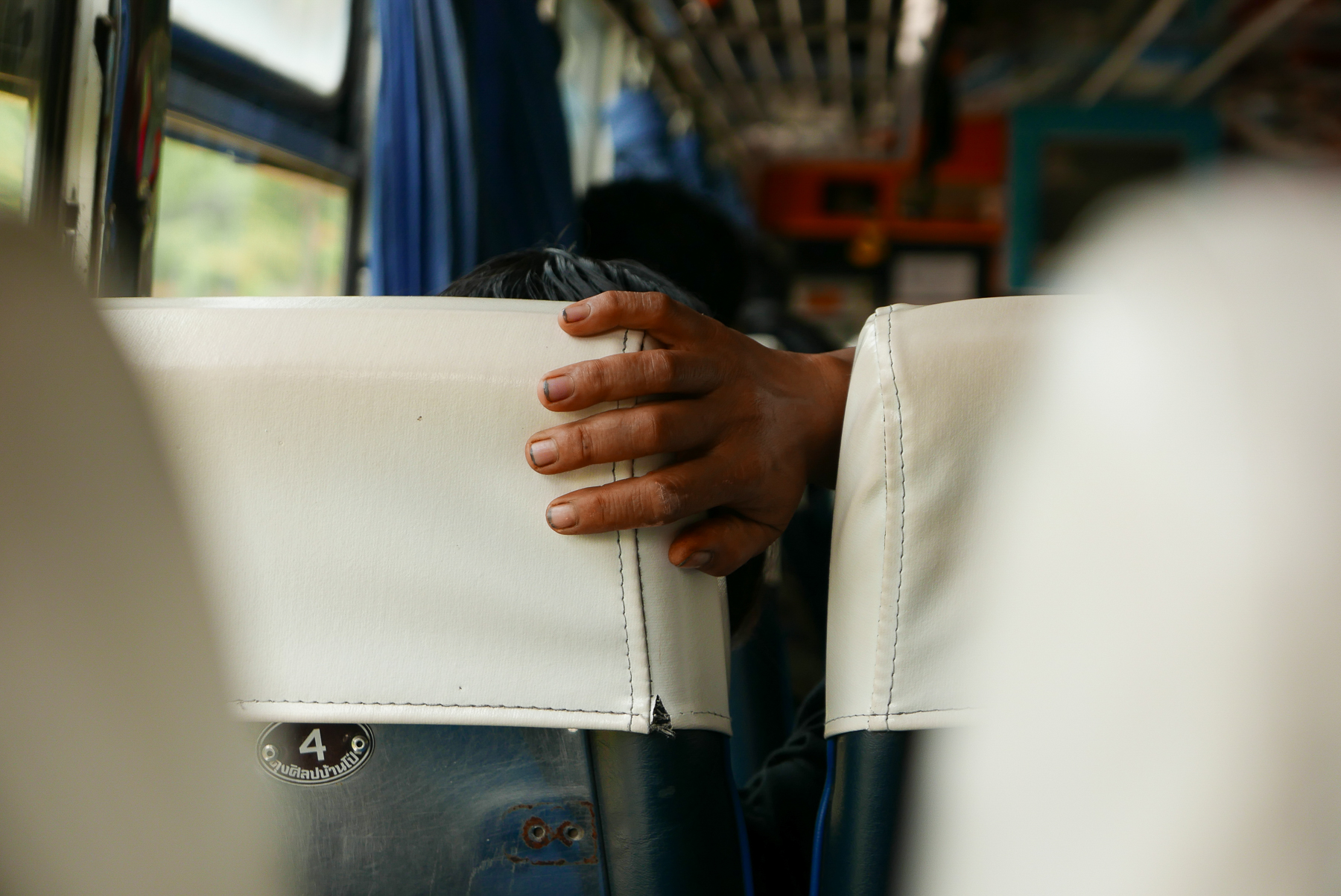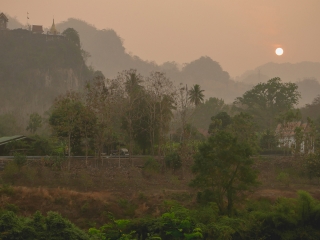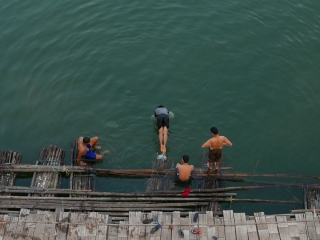Once the Thai-Burmese border became the next target of my trip, I learned to look for platforms filled with locals in major bus terminals or for small bus stations near marketplaces. It was after the experience in the crammed, heavily air-conditioned and dangerously fast mini-buses of Southern Thailand that “VIP bus” became something to avoid rather than take comfort in. Nothing to see there other than the driver honking incessantly and the other passengers, all tourists, dozing off with their headphones on. It dawned on me that the locals also needed to travel. With a bit of persistence and naive smiles, I managed to dodge the luxury buses that every ticket seller was trying to force on me and ended up on the network of local buses. The strategy paid off as it opened a whole new world.

Thai public buses defy words. To describe them as metallic boxes with holes for windows or doors, more like carcasses of actual buses, would be too precipitated, because there are various details, like the refreshing breeze that comes in through the open windows and doors, the velvety curtains in strong colors, the mirror-like polish of the ceiling, the totally random distribution of seat numbers, the mix of working and non-working fans, or the snow-white leather headrests, which only become apparent after a while and give a weirdly charming character to the ride.

A driver and a bus assistant (usually a middle-aged woman walking down the bus aisle and shaking a tube-like wallet with coins and tickets to announce her presence) run the show in each bus. The mood of the bus assistant can greatly influence the atmosphere in the vehicle, because they also assign seats, prompt the driver to stop when a passenger wants to get off, and try to avoid the buildup of clutter. To some extent, the bus assistants are like the soul of a bus, and many of my rides were imbued with a pleasant feeling thanks to these ladies who went to great lengths to make sure we were comfortable enough, told jokes to entertain the passengers, and watched over me throughout.
The journey from Central Thailand to Sangkhlaburi, my first destination in the border region, took a day and involved four different buses, with little waiting in-between. The rhythm of daily life was accurately reflected by the passengers on the bus. In the early morning, schoolchildren in starched uniforms flooded the bus, a few banknotes in their hands, which they gave without a word to the bus assistant. The driver knew where to pick up and drop off these silent figures confined to morning grumpiness, and we made frequent stops for that purpose, until the clock hit 8 and we steered to the fast lane.
Before noon, morning sellers boarded the bus to return home from the market. One of them, a young and confident woman, sat next to me and offered me a box of her leftover produce: a delicious dessert made out of dried guava skin. The “price” revealed itself soon enough: the woman wanted a selfie together with me eating her food. Still chewing, I clumsily agreed, and one minute later the woman showed me the photo already posted on her Facebook.

In the afternoon, as we began to crawl up winding roads in the mountains, villagers boarded the bus to return home with their market catches. A cheerful family of five occupied the entire back part of the bus and stacked all sorts of bags and cardboard boxes on top of each other. The contents of these remained a mystery, except for one, which they pierced to the great amusement of their baby: the head of an inquisitive rooster came out. And another market catch in a gray bag, placed at the front of the bus on a little raised platform like on some sort of altar, intrigued me for hours as I stared at it and refused to believe it was exactly what it appeared to be: pig’s ears and entrails.

“I see you like to take photos from the bus,” a man approached me when we were close to Sangkhlaburi. He was a Thai living in Australia and doing church work. Thanks to his job he could travel worldwide, and was now spending part of his holiday in his home country. We talked about Thailand and how tourism had changed the country. He warned me that Sangkhlaburi would be a touristy place too, visited not as much by farangs as by Thais themselves. And then he pointed to some women in the bus in long handwoven skirts with fine embroidery. They were not Thai, because Thai women would no longer wear traditional clothing like this. Suddenly the group I was riding with did not seem so homogenous anymore and I realized I had before me the people who had attracted me to this part of Thailand in the first place.
Sangkhlaburi and its surroundings are home to a significant Mon population, an ethnic group who fled the violence of the regime in their home country, Burma, and sought asylum in Thailand over the past two hundred years. They were allowed to settle along the border, but cannot travel outside a specific area, which is why the region is dotted with police checkpoints. Each time they boarded the bus, the officers immediately eyed those they needed to check. (As an outsider, it was difficult to spot any difference between the Thai and the Mon except the attire, though I was told at some point that the Mon generally have more beautiful features.) And each time, the same routine: the person handed the officer their ragged papers, an unfriendly questioning ensued, the officer moved on. Many Mon have a Thai ID, but almost none of the rights of a proper citizen. They live like ghosts, clinging to their language and culture. This was also what I found when I got off the bus and headed to the Mon side of Sangkhlaburi: a seemingly deserted place with only a handful of people toiling up and down the steep streets. But it was late afternoon and, as usual at that hour, the heat was oppressive, so I decided to give it another shot in the morning.





Leave a Reply